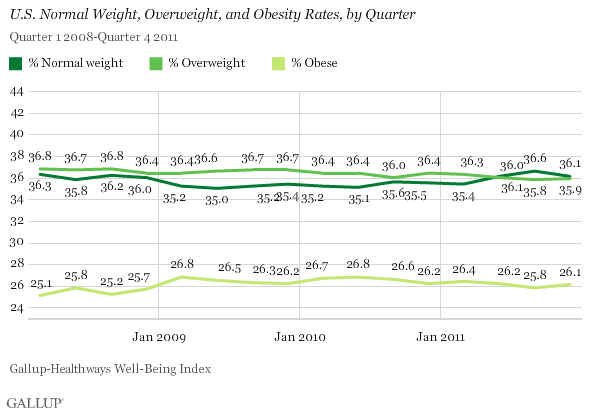WASHINGTON, D.C. -- Slightly fewer American adults were obese in 2011 (26.1%) than in 2010 (26.6%) and 2009 (26.5%). This decline was largely offset by a slight increase in the percentage of Americans reporting a normal weight -- increasing to 36.1% last year from 35.4% in 2010 -- while the percentage overweight, but not obese, showed less change.

Gallup has tracked Americans' weight status since 2008. Over this period, the total percentage overweight or obese rose from 62.2% in 2008 to 63.1% in 2009. It has since declined slightly each year to 62.9% in 2010 and to 62.1% in 2011.
The 2011 data encompass more than 300,000 surveys of American adults. The Gallup-Healthways Well-Being Index uses respondents' self-reports of their height and weight to calculate body mass index (BMI) scores. Individual BMI values of 30 or above are classified as "obese," 25 to 29.9 are "overweight," 18.5 to 24.9 are "normal weight," and 18.4 or less are "underweight."
Quarterly tracking of Americans' weight situation reveals that obesity levels were lower in every quarter of 2011 compared with the corresponding quarter in 2010.

Obesity Declines or Remains Unchanged Across All Key Subgroups
The percentage of Americans who were obese in all major demographic and socio-economic groups either declined slightly or stayed the same in 2011 compared with 2010. Blacks, low-income Americans, and those aged 45 to 64 were still the most likely to be obese in 2011, as they have been in past years, with more than 3 in 10 in each group weighing enough to be considered obese. Young adults and high-income Americans remained among the least likely to be obese.

Bottom Line
The slight drop in America's obesity rate is a positive reversal of what was previously a negative trend. The cost of obesity is so high that even this small improvement has the potential to save the American economy a significant amount of money. A December 2010 analysis by the Society of Actuaries estimates that the total cost of obesity to the U.S. economy has climbed as high as $270 billion. Gallup's own analysis finds that obesity and related chronic health issues cost businesses alone upward of $150 billion annually. But with more than one in four adults still obese, the nation has a long way to go to achieve lasting change.
Blacks, low-income Americans, and those who are middle aged continue to be the groups most likely to be struggling with obesity. Decreasing the obesity rate among these groups would have a significant effect on Americans' collective health and healthcare costs. The new U.S. healthcare law could help to address obesity among low-income Americans, if those who are currently uninsured are able to secure coverage and take advantage of the free preventative services required under the law including counseling on losing weight. However, regardless of whether they have access to and attend counseling, all Americans need to exercise more and eat better because nearly half are not doing so.
About the Gallup-Healthways Well-Being Index
The Gallup-Healthways Well-Being Index tracks well-being in the U.S., U.K., and Germany and provides best-in-class solutions for a healthier world. To learn more, please visit well-beingindex.com.
Survey Methods
Results are based on telephone interviews conducted as part of the Gallup-Healthways Well-Being Index survey Jan. 1-Dec. 31, 2011, with a random sample of 335,050 adults, aged 18 and older, living in all 50 U.S. states and the District of Columbia, selected using random-digit-dial sampling.
For results based on the total sample of national adults, one can say with 95% confidence that the maximum margin of sampling error is ±0.2 percentage points.
For results based on subgroups, one can say with 95% confidence that the maximum margin of sampling error is ±1 percentage point.
Interviews are conducted with respondents on landline telephones and cellular phones, with interviews conducted in Spanish for respondents who are primarily Spanish-speaking. Each sample includes a minimum quota of 400 cell phone respondents and 600 landline respondents per 1,000 national adults, with additional minimum quotas among landline respondents by region. Landline telephone numbers are chosen at random among listed telephone numbers. Cell phone numbers are selected using random-digit-dial methods. Landline respondents are chosen at random within each household on the basis of which member had the most recent birthday.
Samples are weighted by gender, age, race, Hispanic ethnicity, education, region, adults in the household, and phone status (cell phone only/landline only/both, cell phone mostly, and having an unlisted landline number). Demographic weighting targets are based on the March 2010 Current Population Survey figures for the aged 18 and older non-institutionalized population living in U.S. telephone households. All reported margins of sampling error include the computed design effects for weighting and sample design.
In addition to sampling error, question wording and practical difficulties in conducting surveys can introduce error or bias into the findings of public opinion polls.
For more details on Gallup's polling methodology, visit www.gallup.com.
